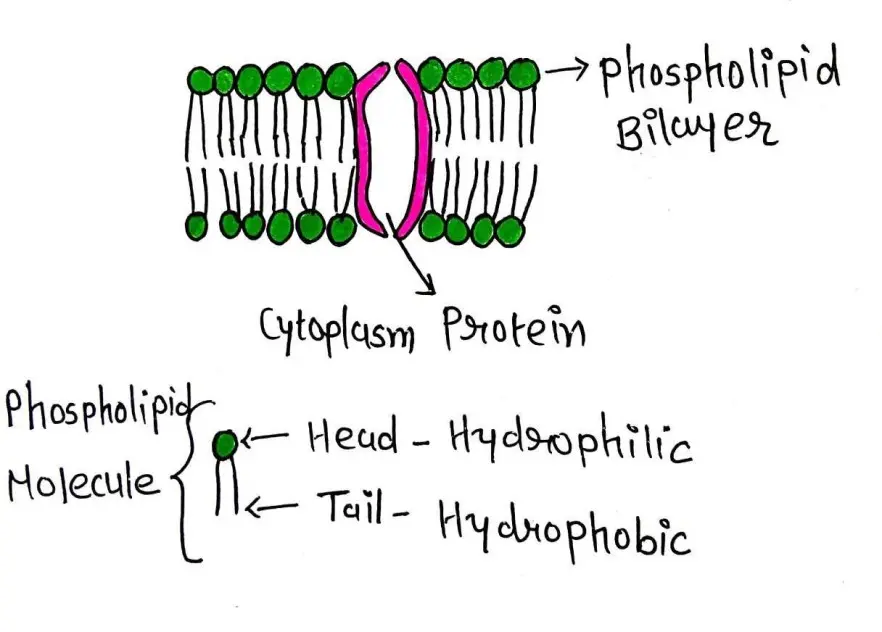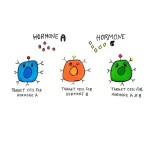
Hi friends, in this post we will study about the Internal Structures of Bacteria, but before starting here you should read the previous two related posts Morphology of Bacteria and External Structures of Bacteria.
So let’s start with the list of the structures that lies internal to the bacterial cell wall.
[Note: Words with ( * ) are particularly defined at the end of this post.]
STRUCTURES INTERNAL TO CELL WALL
- Cytoplasmic membrane
- Intracellular membrane system
- Cytoplasm
- Cytoplasmic inclusions and vacuoles
- Nucleoids
Table of Contents
ToggleCYTOPLASMIC MEMBRANE

Situation
Just below the cell wall.
Structure
- It is Bilayered membrane with 75 nm of thickness.
- It is made up of phospholipids (about 20-30%) and proteins (about 60-70%).
- The bilayer is formed by phospholipids in which proteins are closely arranged.
- Each phospholipids molecule has both head hydrophilic and hydrophobic.
- Hydrophilic head facing outwards and a hydrophobic tail facing towards each other.
- It is similar in both Gram + ve and Gram -ve bacteria.
- The lipid matrix of the membrane has fluidity.
- This type of structure of plasma membrane is known as fluid mosaic model.
Functions
- Act as a hydrophobic barrier for the water-soluble molecules.
- Act as a semi permeable membrane- Specific membrane proteins facilitate the transmission of small molecules (nutrients & waste products) across the membrane.
- It contains various enzymes required for respiratory metabolism and synthesis of capsular and cell wall components.
INTRACELLULAR MEMBRANE SYSTEM
Mesosome/ Chondrioids
- These are the inverted folds of cell membrane that can increase their surface area for certain function.
- Especially in gram positive bacteria they are in the form of tortuous tubules and vesicles*.
- They may be 2-4 in number in each cell.
- The mesosomes may be central or peripheral in position.
The central mesosome penetrate deeply into the cytoplasm.
While the peripheral mesosome show only a shallow penetration & seem to be involved in export of exocellular enzymes such as penicillinase.
- But it is does not have many plasma membrane enzymes like.
ATPase, dehydrogenase, and cytochrome. It has been suggested that mesosomes help in the formation of septum.

Ribosomes
- Ribosomes are found in free floating conditions which are randomly distributed in the cytoplasm.
- The cytoplasm contains 10000-15000 ribosomes which are the reason for granular appearance under microscope.
- Protein synthesis takes place inside ribosomes.
- The growing cells have a large number of ribosomes.
- They are made up of two subunits, each contains proteins & RNA (rRNA).
- Prokaryotic ribosomes are known as 70s ribosome*.
- It is composed of two subunits larger 50S and a smaller 30S.
- Many antibiotics like streptomycin and tetracycline inhibit the protein synthesis by targeting on the ribosome of the bacterium.

Lamellae or Chromatophore
- These chromatophore are hollow rounded, colored structure with a diameter of about 300 Å.
- They are found in some photosynthetic bacteria.
- They are distributed throughout the cytoplasm.
- They contain photosynthetic pigments, enzyme required for light reaction & Electron Transport system of photophosphorylation.

CYTOPLASM
- Cytoplasm means the substance of the cell inside the plasma membrane.
- The 80% of cytoplasm is water and contains nucleic acid, protein, lipids, carbohydrates, inorganic ions and many low molecular weight compounds.
- It is thick, aqueous, elastic & semi-transparent.
- Major part contains nucleoid, ribosome particles & deposits of inclusions.
- Prokaryotic cytoskeleton plays role in cell division, maintains shape of the cell, growth, movement of DNA, targeting of proteins and arrangement of organelles.
- They are not able for movement of the fluid substance. (cytoplasmic streaming).
CYTOPLASMIC INCLUSIONS & VACUOLES
Inclusions Bodies
- Prokaryotic cells contain several kinds of reserve deposits within the cytoplasm known as Inclusions.
- Cells may accumulate certain nutrients when they are in abundant and utilize them when there is deficiency in the environment.
- Some inclusions are common in many of bacteria, while some are limited to a small number of species.
1.Metachromatic granules
- They are large inclusions which stains red with methylene blue dye.
- Collectively they are known as volutin.
- They store inorganic phosphate (polyphosphate) which can be utilized in ATP synthesis.
- They are formed by cells when there are phosphate rich environments.
- They are found in algae, fungi, protozoa and bacteria.
2. Polysaccharide Granules inclusions
- Polysaccharide granules usually contain glycogen and starch.
- Their presence can be observed after Iodine application.
3.Lipid Inclusions
- They are common lipid-storage material found in various species of Mycobacterium, Bacillus, Azotobacter, Spirillum etc.
- They can be observed by staining with fat-soluble dyes, like Sudan dyes.
4.Sulphur Granules
- Certain bacteria obtain energy by oxidizing sulphur and sulphur containing compounds.
- They accumulate sulphur granules in the cell, which serve as an energy reserve.
5.Carboxysomes inclusions
- They contain the enzyme ribulose 1,5-diphosphate carboxylase.
- Photosynthetic bacteria require this enzyme for carbon dioxide fixation.
- Examples are nitrifying bacteria, cyanobacteria, and acidithiobacillus.
6.Magnetosome inclusions
- Storage of iron oxide, surrounded by plasma membrane.
- Formed by many Gram-negative bacteria & act like magnets.
- Helps in downward movement to reach suitable environment.
- Protect the cell from hydrogen peroxide accumulation.
GAS VACUOLES
- They are hollow cavities.
- Each vacuole contains rows of many individual gas vesicles.
- Bacteria living in aquatic environment form gas vacuoles which help them to float on the surface.
- So, they can receive sufficient amount of oxygen, light & nutrients even after remaining in the depth of water at appropriate level.
THE NUCLEOID
Bacterial chromosomes
- A single long, continuous, repeatedly arranged in circular pattern, thread of double-stranded DNA.
- This is the genetic information required for structure & functions of the cell.
- Bacterial chromosomes are not surrounded by nuclear membrane.
- They do not contain histone proteins.
- Nucleoids may be spherical, elongated or dumbbell shaped.
Plasmids
- In many bacteria in addition to bacterial chromosome, there is a small circular DNA segment which is in the form of ring and is called Plasmid.
- They are not connected to main bacterial chromosome.
- They replicate independently and have their own system for initiating and controlling the replication.
- Plasmid has no role in viability and growth of bacteria.
- Two types of plasmids have been identified:
- Conjugative Plasmid: It carries genes that promote the transfer of plasmids from host cell to a recipient cell by conjugation.
- Non-conjugative Plasmid: It can’t promote its own transfer by conjugation.
Episomes
These are the plasmid which are united with the bacterial chromosomes.
REFERENCE TERMINOLOGIES
Vesicles-A small bladder or sac filled with fluid.
70S ribosome-The letter ‘S’ is for Svedberg units, it indicates sedimentation rate during ultra-high-speed centrifugation.
- It has two subunits-30S & 50S.
- 30S subunits are small with one molecule of rRNA.
- 50S subunits are large with two molecules of rRNA.
- Note-70S value is not the sum of 30S plus 50S.
Eukaryotic ribosomes are known as 80S ribosomes.













Leave a Reply